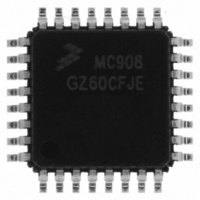MC908GZ60CFJE Freescale Semiconductor, MC908GZ60CFJE Datasheet - Page 243

MC908GZ60CFJE
Manufacturer Part Number
MC908GZ60CFJE
Description
IC MCU 60K FLASH 8MHZ 32-LQFP
Manufacturer
Freescale Semiconductor
Series
HC08r
Datasheet
1.MC908GZ60CFJE.pdf
(352 pages)
Specifications of MC908GZ60CFJE
Core Processor
HC08
Core Size
8-Bit
Speed
8MHz
Connectivity
CAN, SCI, SPI
Peripherals
LVD, POR, PWM
Number Of I /o
21
Program Memory Size
60KB (60K x 8)
Program Memory Type
FLASH
Ram Size
2K x 8
Voltage - Supply (vcc/vdd)
3 V ~ 5.5 V
Data Converters
A/D 24x10b
Oscillator Type
Internal
Operating Temperature
-40°C ~ 85°C
Package / Case
32-LQFP
Controller Family/series
HC08
No. Of I/o's
21
Ram Memory Size
2KB
Cpu Speed
8MHz
No. Of Timers
2
Embedded Interface Type
CAN, SCI, SPI
Rohs Compliant
Yes
Processor Series
HC08GZ
Core
HC08
Data Bus Width
8 bit
Data Ram Size
2 KB
Interface Type
CAN, ESCI, SPI
Maximum Clock Frequency
8 MHz
Number Of Programmable I/os
53
Number Of Timers
8
Maximum Operating Temperature
+ 85 C
Mounting Style
SMD/SMT
Development Tools By Supplier
FSICEBASE, DEMO908GZ60E, M68EML08GZE
Minimum Operating Temperature
- 40 C
On-chip Adc
10 bit, 24 Channel
Lead Free Status / RoHS Status
Lead free / RoHS Compliant
Eeprom Size
-
Lead Free Status / Rohs Status
Details
Available stocks
Company
Part Number
Manufacturer
Quantity
Price
Company:
Part Number:
MC908GZ60CFJE
Manufacturer:
Freescale
Quantity:
4 000
Company:
Part Number:
MC908GZ60CFJE
Manufacturer:
Freescale Semiconductor
Quantity:
10 000
- Current page: 243 of 352
- Download datasheet (5Mb)
The maximum frequency of the SPSCK for an SPI configured as a slave is the bus clock speed (which is
twice as fast as the fastest master SPSCK clock that can be generated). The frequency of the SPSCK for
an SPI configured as a slave does not have to correspond to any SPI baud rate. The baud rate only
controls the speed of the SPSCK generated by an SPI configured as a master. Therefore, the frequency
of the SPSCK for an SPI configured as a slave can be any frequency less than or equal to the bus speed.
When the master SPI starts a transmission, the data in the slave shift register begins shifting out on the
MISO pin. The slave can load its shift register with a new byte for the next transmission by writing to its
transmit data register. The slave must write to its transmit data register at least one bus cycle before the
master starts the next transmission. Otherwise, the byte already in the slave shift register shifts out on the
MISO pin. Data written to the slave shift register during a transmission remains in a buffer until the end of
the transmission.
When the clock phase bit (CPHA) is set, the first edge of SPSCK starts a transmission. When CPHA is
clear, the falling edge of SS starts a transmission. See
16.4 Transmission Formats
During an SPI transmission, data is simultaneously transmitted (shifted out serially) and received (shifted
in serially). A serial clock synchronizes shifting and sampling on the two serial data lines. A slave select
line allows selection of an individual slave SPI device; slave devices that are not selected do not interfere
with SPI bus activities. On a master SPI device, the slave select line can optionally be used to indicate
multiple-master bus contention.
16.4.1 Clock Phase and Polarity Controls
Software can select any of four combinations of serial clock (SPSCK) phase and polarity using two bits
in the SPI control register (SPCR). The clock polarity is specified by the CPOL control bit, which selects
an active high or low clock and has no significant effect on the transmission format.
The clock phase (CPHA) control bit selects one of two fundamentally different transmission formats. The
clock phase and polarity should be identical for the master SPI device and the communicating slave
device. In some cases, the phase and polarity are changed between transmissions to allow a master
device to communicate with peripheral slaves having different requirements.
16.4.2 Transmission Format When CPHA = 0
Figure 16-5
replacement for data sheet parametric information.
Two waveforms are shown for SPSCK: one for CPOL = 0 and another for CPOL = 1. The diagram may
be interpreted as a master or slave timing diagram since the serial clock (SPSCK), master in/slave out
(MISO), and master out/slave in (MOSI) pins are directly connected between the master and the slave.
The MISO signal is the output from the slave, and the MOSI signal is the output from the master. The SS
line is the slave select input to the slave. The slave SPI drives its MISO output only when its slave select
Freescale Semiconductor
shows an SPI transmission in which CPHA = 0. The figure should not be used as a
SPSCK must be in the proper idle state before the slave is enabled to
prevent SPSCK from appearing as a clock edge.
Before writing to the CPOL bit or the CPHA bit, disable the SPI by clearing
the SPI enable bit (SPE).
MC68HC908GZ60 • MC68HC908GZ48 • MC68HC908GZ32 Data Sheet, Rev. 6
NOTE
NOTE
16.4 Transmission
Formats.
Transmission Formats
243
Related parts for MC908GZ60CFJE
Image
Part Number
Description
Manufacturer
Datasheet
Request
R
Part Number:
Description:
Manufacturer:
Freescale Semiconductor, Inc
Datasheet:
Part Number:
Description:
Manufacturer:
Freescale Semiconductor, Inc
Datasheet:
Part Number:
Description:
Manufacturer:
Freescale Semiconductor, Inc
Datasheet:
Part Number:
Description:
Manufacturer:
Freescale Semiconductor, Inc
Datasheet:
Part Number:
Description:
Manufacturer:
Freescale Semiconductor, Inc
Datasheet:
Part Number:
Description:
Manufacturer:
Freescale Semiconductor, Inc
Datasheet:
Part Number:
Description:
Manufacturer:
Freescale Semiconductor, Inc
Datasheet:
Part Number:
Description:
Manufacturer:
Freescale Semiconductor, Inc
Datasheet:
Part Number:
Description:
Manufacturer:
Freescale Semiconductor, Inc
Datasheet:
Part Number:
Description:
Manufacturer:
Freescale Semiconductor, Inc
Datasheet:
Part Number:
Description:
Manufacturer:
Freescale Semiconductor, Inc
Datasheet:
Part Number:
Description:
Manufacturer:
Freescale Semiconductor, Inc
Datasheet:
Part Number:
Description:
Manufacturer:
Freescale Semiconductor, Inc
Datasheet:
Part Number:
Description:
Manufacturer:
Freescale Semiconductor, Inc
Datasheet:
Part Number:
Description:
Manufacturer:
Freescale Semiconductor, Inc
Datasheet:











